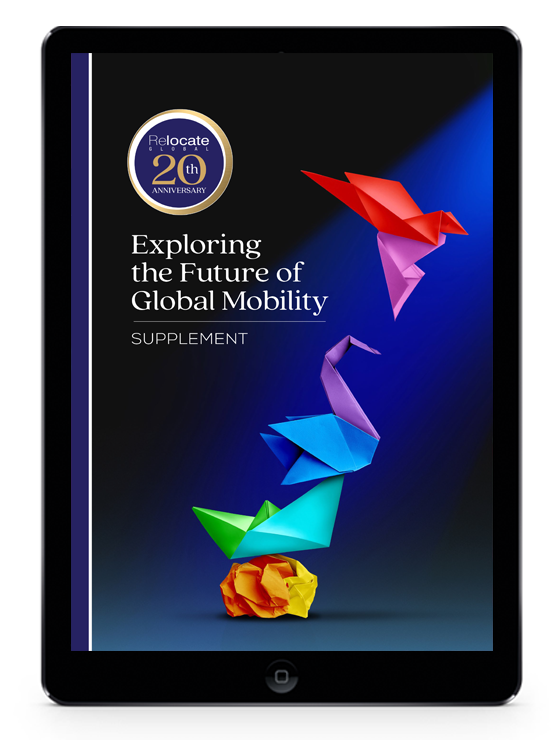Pensions and financial wellbeing as an employee retention tool
In the global race to recruit and retain talent, putting financial wellbeing and financial security at the heart of employee perks and benefits could be a gamechanger, writes Marianne Curphey.
With the exception of perhaps the Civil Service, the generosity of the pension scheme offered by an organisation is rarely a deciding factor in whether to join a company or to continue to work there. With exciting new FinTech innovations entering the pensions arena this could change, opening up new opportunities for employers to demonstrate their commitment to employees’ long term financial welfare. It could also enable companies to gain an edge when it comes to engaging with staff on issues that matter most to them.
When individuals work for years outside their home country, they may have various pension options depending on their specific circumstances and the pension systems in place. If they have not contributed to a pension scheme during their time abroad, employees may need to rely on personal savings and investments to fund their retirement.
Financial security is high on the agenda for many employees as the cost of living bites. A new survey by Investing Reviews found that 70% of respondents believe that it is harder to retire comfortably today than ever before. In addition, 78% of respondents also believe the retirement age in the UK should be lowered, whilst 42% would prefer to leave the UK and live abroad for their retirement.
The HireVue 2023 Global Trends Report found that over the past year employees were still voluntarily leaving their jobs at higher-than-usual rates, just as they had in 2021. In fact, 50% of respondents said resignations were even higher at their company than they had been the year before. Giving your staff a good reason to stay, both in terms of career progression and employee engagement, could help to stem this outward flow.
Financial benefits that are wider than straightforward pay can also have a beneficial impact on a company’s overall business performance. A new report by London Economics which was commissioned by HMRC into the value and use of employee share schemes found good outcomes. It found that a company share scheme had a positive impact on employment outcomes and on employee productivity and sense of connection to the company which could lead to improved company performance.
Why do pensions need to change and what part can employers play?
International pension plans are proving to be effective vehicles for delivering long-term retirement benefits for global nomads and other long-term assignees moving from location to location.
“In the market, we’re seeing businesses take action ranging from bringing their tax governance up to date and checking their policies through to transforming their pension offering for cross-border executives,” says Robert Rothery
Director, KPMG in the US, in the recent report Great Expectations: How expectations of pay, borders, mobility and life are changing.
“Pension and benefits have always raised special tax and legal challenges related to mobile workers,” he says. “This is especially true for the small but highly valued group of global nomads who move from one international assignment to another and are often restricted from taking part in national pension and social security schemes.”
Making pensions relevant to a new generation of global workers
“People’s expectations are higher since Covid,” says Ann Ellis, CEO, Mauve Group. “In the past, I wouldn’t have said that people were always expecting to have health insurance, but that is something they are asking from employers as a norm now and as part of their job package. Even with young staff, there is an interest in pensions, what they will receive and what their pension might be worth at the end of the day. This younger generation seems to be much more interested in pensions and long-term savings than they would have been in the past.”
There are other trends which could also help workers become more engaged with their financial future and which employers could harness to increase employee retention. But pensions are complex and in order to help people really understand the importance of saving for the future, financial education needs to become more immersive, with the introduction of virtual and mixed reality approaches.
“We expect to see a drive towards gamification in order to meet the requirements of the newer generations entering the workforce,” says Vito Faircloth, Chief Digital Officer at Isio, a leading independent UK provider of actuarial consulting, pensions administration, investment advisory, employee benefits and wealth management services. There is a drive towards consolidation and demand for individuals to view all of their pension contributions and overall finances in one place, he says.
“Modern immersive technologies like Virtual Reality will help individuals to zoom out on what the detail of their pension is today and look at their future forecast to assess if their current level of savings will help them to secure the life they want in the years to come,” he says.
“It will be possible to extrapolate current and future earnings, pension contribution forecasts and what your final pot size would look like based on different savings scenarios. Individuals will be able to access a visualisation of their living standards in retirement. This level of education will reassure some that their approach is right and for others, signal a change needs to be made. The use of virtual reality can bring a vision for future to life in a way that we haven’t done so before.”
Why technology could herald a revolution in pensions
Given that employers are now obliged to offer a pensions option in the UK workplace via auto-enrolment, companies could be missing a trick by not using pensions to engage more closely with staff and consolidate the relationship of trust that already exists.
“For many employers, the pension contributions that they are making on behalf of their staff can be the second biggest line of cost after the main payroll,” says Ben Pollard, Founder and CEO of Cushon, a FinTech pensions and savings provider which has just joined forces with NatWest to provide financial products to NatWest’s commercial customers. “Employers are spending all this money and yet they are not taking the opportunity to engage with staff and spell out the real benefit of what they are providing. Effectively, for the employee it is free money if they are part of the pension scheme.
“What employers should be providing is a benefit that employees value and like and causes them to want to carry on working for you and want to come and work for you in the first place. As an employer, you are one of the most trusted authorities in many people’s lives. And there is an enormous ability to connect and help people.”
He says a tech revolution in financial services is long overdue, and an employer that runs a pension scheme effectively could afford to give staff a more than 3% pay rise on account of the National Insurance contributions which could be saved and recycled. At a time when employees are facing financial pressures, this could be a valuable retention tool.
“If you look at most other industries and aspects of our lives, they have all been completely revolutionised over the last decade,” he says. “But financial services in general, and workplace savings and pensions in particular, are still looking and feeling really quite similar to how they did a decade ago.
“We often talk to employers and explain how they could help staff to get on the housing ladder or help them save to put their children through university or help them save for their next holiday rather than putting on their credit card. That would be a huge and tangible benefit to their staff which could really cement the workplace relationship.”
What does the future hold for workplace pensions and benefits for companies with globally mobile employees?
The next few years are critical for pensions providers and employers as they look to re-engage with customers around their retirement savings.
“Auto-enrolment in the UK has led to an increase in the number of pension pots that people need to keep track of,” says Jason Whyte, financial services expert, PA Consulting. “A key focus for the industry is to help savers form a view of their total pension wealth and make good decisions about how to plan and manage their retirement.”
He believes digitisation will be a way to reconnect and organise fragmented retirement savings and that new systems will emerge to help individuals manage all their financial savings and commitments.
“Globally, we are seeing the rise of “financial ecosystems” that help customers address a wide range of financial needs, generally centred around a primary brand and an online hub but drawing in other providers and using other channels where appropriate,” he says.
“The leading ecosystem brands have captured the imagination of customers, and with it a much greater share of their financial lives than traditional approaches. One thing that successful ecosystem players around the world have in common is a genuine commitment to create value for their customers and helping them to engage with all of their finances – short and long term – in a consistent way and so that they can break down big decisions into smaller and easier steps.”
He says that for this to happen in the UK – and for providers to unlock the potential value of digitising pensions – it requires a big transformation and a different approach to business models and risk management. But for those who succeed, the prize is huge.
Women lag behind men in pension security – why pensions are an important factor in DE&I policies
Another reason to look again at how employees are interacting with your workplace pension is around equality and diversity. Government figures released this month (June 2023) show a widening gap in pension provision between men and women. The Gender Pensions Gap in Private Pensions makes sobering reading for a generation of women who may not be able to afford to retire until their 70s.
Laura Suter, AJ Bell’s head of personal finance and founding ambassador of the AJ Bell Money Matters campaign, says the government statistics show women have 35% lower pension pots when they hit retirement age compared to men. On average this means that for every £100 a man has in his pension, a woman has just £65.
“When we drill down into the numbers, it’s not a lack of participation on women’s part, the number contributing to a pension is high,” she explains. “Looking at just auto-enrolment participation women are consistently more likely to be paying into a pension than men. And in fact, when women are in their 30s the gender pension gap is at its smallest, at 10%. But once they hit their 40s and above women significantly drop behind men in their pension savings.”
A lot of this will be due to women taking career breaks to have children, working part-time around caring responsibilities or the gender pay gap meaning they earn less – which all filters through to lower incomes and lower pension contributions.
PensionBee Director of Public Affairs Becky O’Connor, says women are on average currently retiring with a pension of about two thirds of the value of men’s, with women reaching age 55 with about £100,000, on average and men with about £150,000. Importantly, the data does not count instances where there is no pension at all. If it did, the gap would be even greater.
Often the problem comes when women reach their child-raising years and need to take some time out of paid work.
“It is therefore policy in this area, such as equal pay for new mothers and fathers, that probably requires the most attention if we are to close the gap,” she says.
Laura Suter echoes this. “From maintaining pension payments during maternity leave, to increasing contributions if you return to work part-time, or boosting contributions before you go off, there are lots of ways to ensure a career break doesn’t leave a huge hole in pension savings,” she says. “There’s also lots of evidence to show that women don’t ask for pay rises as often as men, and a bigger income means bigger pension contributions.”
Melissa Blissett, Senior Consultant – Pay Gap Analytics and Financial Wellbeing at Barnett Waddingham says women in retirement face “a dangerous combination of a smaller pot size and more years to fund for”.
“The gender pay gap remains at 14.9%, highlighting a huge problem for women who are struggling to obtain higher paid work, or progress within their career. And this varies depending on age and ethnicity factors – a one size fits all approach won’t cut it, we need to identify specific issues in order to implement tangible and effective action plans,” she says.
She suggests review the design of their pension offering to ensure equity across the workforce.
“Elements such as reviewing any tiered matching contribution rates (which are arguably intrinsically gender biased) and introducing pension contribution auto-escalation, particularly after periods of parental leave, could create better outcomes overall,” she says.


 Magazine
Magazine



Trackbacks/Pingbacks